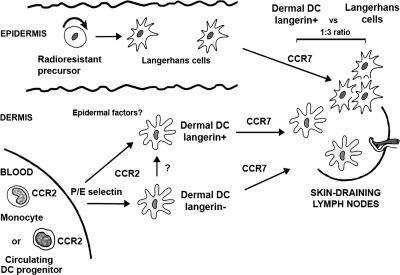Figure 7.
Origin of langerin+ DC in mice. This diagram illustrates a hypothetical view on cutaneous DC differentiation pathways in mice in the steady state. Epidermal LCs are maintained by radioresistant hematopoietic progenitors that have taken residence in the skin before birth, whereas the majority of dermal DCs derive from circulating DC precursors. Our results now suggest that circulating blood-derived CCR2+ DCs are constitutively recruited to the dermis. E- and/or P-selectin direct this recruitment in transplanted animals, and studies are conducted in the laboratory to examine if this is also true in nontransplanted mice. In response to cutaneous factors, CCR2+ DCs differentiate into dermal langerin+ DCs, but might also be able to differentiate into dermal langerin−CX3CR1+/− DCs. Dermal langerin+ DCs transit, but do not accumulate in the dermis, where they capture skin antigens, before emigrating to the skin DLNs to present skin-derived peptides in the context of MHC molecules. Both LCs and dermal DCs require CCR7 to migrate to the T cells area of skin DLNs. In the skin DLNs, dermal langerin+ DCs are undistinguishable from LC-derived DCs, and they are characterized as CD8−langerin+CD11clo, but differ from blood-derived CD8+ langerinloCD11hi DCs. Whether CCR2+ blood precursors that give rise to dermal langerin+ DCs and contribute to CD8−langerin+ CD11clo in the skin DLNs represent a committed DC precursor or a circulating monocyte is currently under study in the laboratory.

